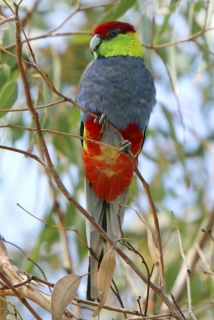Red-capped Parrot |
|
|
Also known as: Pileated Parrot or Parakeet, King Parrot, Western King Parrot, Western Australian King Parrot, Hookbill
Photos
View in GalleryDid You Know?
The elongated upper mandible of the Red-capped Parrot is adapted for dislodging the marri plant's large seeds, which are removed as the fruit is held in the bird's foot.Academic Research
Related publications: Purpureicephalus spuriusSpecies Profile
Genus: Purpureicephalus | Species: spurius
Size:
37cm (14.4 in)
Weight:
105-156g (3.6-5.5 oz)
Subspecies including nominate:
one
Colour Adult:
Male-dark red forehead to nape; yellow/green cheeks; dark green upperparts; green/yellow rump and upper tail coverts; purple/blue foreneck to abdomen and upper flanks; red lower flanks and thighs to undertail coverts intermixed with yellow/green; dark green tail, widely margined and tipped blue/white. Bill blue/grey. Eye dark brown. Female-in general duller than male; green line above eye, and variable green feather scattered through red crown; dull grey/mauve foreneck and chest, turning to purple/blue towards abdomen; underwing stripe, diminishing with age until absent.
Colour Juvenile:
Frontal band rust coloured; dull green crown, nape, throat and foreneck; dull red/brown on breast and abdomen; abdomen suffused with purple/blue; underwing stripe more evident in females. Bill horn coloured with dull yellow at base of lower mandible.
Call:
Calls are described as distinctive and harsh, sometimes rapid. Also a series of sharp shrieks when alarmed. In defence of nest emits rapid chatter.
Video Links:
Video 1More Information:
Content Sources:
CITES
BirdLife International
Cornell Lab of Ornithology/Birds of the World
Parrots: A Guide to Parrots of the World, Juniper and Parr, 1998
ML Media Collection Catalogue 50463, Red-capped Parrot Pupureicephalus spurius, Hilty, Steven, Argentina, Nov. 1991, Cornell Lab of Ornithology. Site
Parrots of the World, Forshaw and Cooper, 1977. 2010 edition
Parrots of the World, Forsaw, 2006.
Parrots in Aviculture, Low, 1992.
Lexicon of Parrots, Thomas Arndt.
Photos
View in GalleryDid You Know?
The elongated upper mandible of the Red-capped Parrot is adapted for dislodging the marri plant's large seeds, which are removed as the fruit is held in the bird's foot.Academic Research
Related publications: Purpureicephalus spuriusSpecies Care
Captive Status:
Not common
Longevity:
Not recorded.
Housing:
Walk-in enclosure, minimum length 4.5m (14.7 ft).
Diet:
Small seed mix such as: canary, millet, and smaller amounts of oats, buckwheat, safflower and a little hemp; limited sunflower seed; spray millet; green leaves such as: Swiss chard, lettuce, sowthistle, dandelion, chickweed; seeding grasses; rearing food made from hard-boiled egg, wholegrain bread and carrot, all ground to crumbly consistency; fruits such as: apple, orange, banana, pomegranate, cactus fruits; complete kibble.
Enrichment:
Enjoys bathing, so provide overhead spray misters or bowls of water. Vigorous chewer, so provide bird-safe, non-sprayed branches of pine, fir and others, heat sterilized pine cones, vegetable tanned leather toys and wood block toys.
Nest Box Size:
Diagonal box 7" x 7" x 28" (17.8cm x 17.8cm x 71.1cm).
Clutch Size:
4-7
Incubation Time:
20 days
Fledging Age:
5 weeks
Hatch Weight:
Not recorded.
Peak Weight:
Not recorded.
Weaning Weight:
Not recorded.
Photos
View in GalleryDid You Know?
The elongated upper mandible of the Red-capped Parrot is adapted for dislodging the marri plant's large seeds, which are removed as the fruit is held in the bird's foot.Academic Research
Related publications: Purpureicephalus spuriusSpecies Wild Status
World Population:
Unknown, increasing.
IUCN Red List Status:
Least Concern
CITES Listing:
Appendix II
Threat Summary:
Not globally threatened. Fairly common, sometimes entering suburbs of Perth. The spread of marri is thought to have benefitted this parrot, however, poor regeneration of nest trees is a long-term cause for concern, and the restricted range of the species compounds the situation. It is further threatened by hunting and persecution.
Range:
SW Western Australia, north to lat. 30 degrees 30's and east to to Great Southern Railway, reaching south to Esperance district.
Habitat:
Found up to 200m (656 ft) in Eucalyptus forest, orchards, towns, wooded paddocks and mallee.
Wild Diet:
Feeds on fruits, seeds of marri and other eucalypts, notably jarra Eucalyptus marginata and E. cornuta; also those of Grevillea, Hakea, Casuarina, Xylomelum, Agonis and grasses Avena fatua. Also takes blossoms of several eucalypts, leaf buds and insects and their larvae, particularly psyllid lerps. Sometimes damages cultivated fruits.
Ecology and Behaviour:
Paired adults quiet, but noisy groups of 20 or more young birds travel in search of food. May forage on roadsides for grass seeds. Courtship is colourful and loud.
Clutch and Egg Size:
4-7 rounded eggs, 26.5 x 22.5mm (1 x 0.8 in).
Breeding Season:
August-December. Nest is in hollow limb or tree cavity.
Related Links:
Wikipedia
Research: Red-capped Parrot: Moult, age and sex determination
Photos
View in GalleryDid You Know?
The elongated upper mandible of the Red-capped Parrot is adapted for dislodging the marri plant's large seeds, which are removed as the fruit is held in the bird's foot.Academic Research
Related publications: Purpureicephalus spuriusMembers Only Resources
Please log-in now to find more research, resources and tools.
Not a Member?
Find more great information:
Gain exclusive access to 600+ pages of additional research, seminars and podcasts, specialists to ask your toughest questions, and dozens of other fun resources - when you become a WPT member.
Join Today >>

































